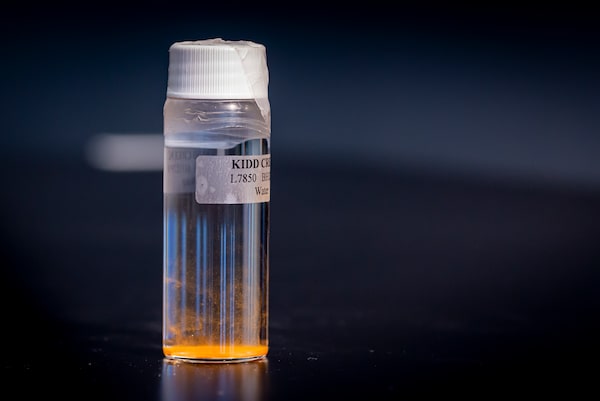
Ingenium, the national science-and-technology museum, has acquired its oldest artifact yet: a bottle of billion-year-old water.Ingenium/Ingenium
Ingenium, the Crown corporation that runs Canada’s national science museums, has acquired its oldest artifact yet: a bottle of billion-year-old water.
The sample of ancient H20 was drawn from the earth’s crust 2.4 kilometres underground, deep in the Kidd Creek copper-and-zinc mine near Timmins, Ont., by University of Toronto geologist Barbara Sherwood Lollar.
The water’s age, determined by chemical analysis, means it has not seen the Earth’s surface since a billion years ago – a time far before dinosaurs, when only the simplest life had formed.

Chemical analysis determined the water’s age to be a billion years.Ingenium/Ingenium
Rebecca Dolgoy, Ingenium’s curator of natural resources and industrial technologies, said she saw the water as a “message in a bottle” from an ancient past that, through study, could tell stories about climate change and humankind’s impact on the environment.
Though, at the same time: “It’s regular water, it’s just extremely, extremely salty,” she said.
“You could drink it. We haven’t, obviously.”
Dr. Sherwood Lollar’s research on the billion-year-old water – along with research into groundwater contamination and contributions to the search for life on Mars – earned her the Gerhard Herzberg Canada Gold Medal for Science and Engineering, a top research prize, last year.
The renowned scientist then gave a 59-millilitre sample of the groundwater to Ingenium for safe keeping. The surprisingly clear liquid rests in a 8.5-centimetre-high glass bottle, with a layer of red-brown sulfate sediment at the bottom that’s kicked up into a tornado when the bottle is spun.

Dr. Sherwood Lollar donated some of her research tools, including a pair of work gloves, a sample of rock from the mine and a field conductivity probe for measuring salinity.Ingenium/Ingenium
If the bottle were opened – which Ingenium says it does not plan to do any time soon – the water would smell like rotten eggs.
When discovered, the water would have hosted ancient rock-eating microbes that, Dr. Dolgoy said, have probably died in transit.
Dr. Sherwood Lollar also donated some of her research tools, including a pair of work gloves, a sample of rock from the mine and a field conductivity probe for measuring salinity.
Dr. Dolgoy said the museum did not pay for the sample. She and the scientist preferred to say the water had been “transferred” to the museum, not donated, because it’s a natural resource.
“I think of it as the transfer of responsibility or as the transfer of stewardship,” Dr. Dolgoy said.
The museum was not planning on conducting its own scientific research of the sample, she said, given all the work Dr. Sherwood Lollar has already done, and instead would plan how to use it as part of a possible exhibit and make it available to future generations of researchers 50 or 100 years from now.
Heritage Minister Steven Guilbeault, who joined Ingenium’s presentation of the artifact by video conference, congratulated the museum for its acquisition.
“It’s a credit to our spirits that despite these challenging times, we can continue doing science and doing really, really cool things like getting a hold of a water sample that’s a billion years old,” he said. “I can’t wait to tell my kids.”
The water sample is being stored at the Ingenium Centre, a newly constructed facility that stores the collections of some of Ottawa’s national museums. The centre was originally planned to open to the public earlier this year, but that has been delayed due to the pandemic.
Our Morning Update and Evening Update newsletters are written by Globe editors, giving you a concise summary of the day’s most important headlines. Sign up today.
 Chris Hannay
Chris Hannay